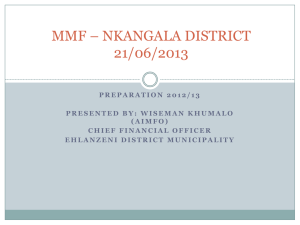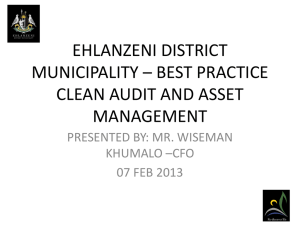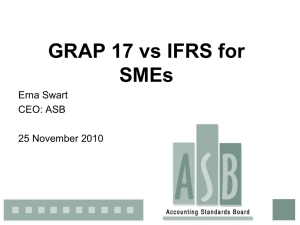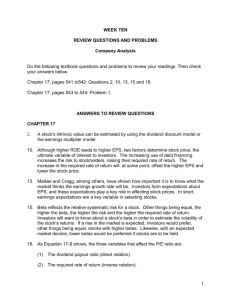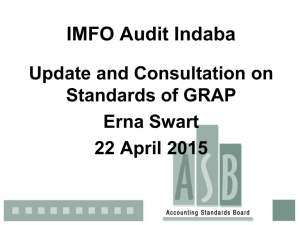Change in accounting policies, accounting
advertisement
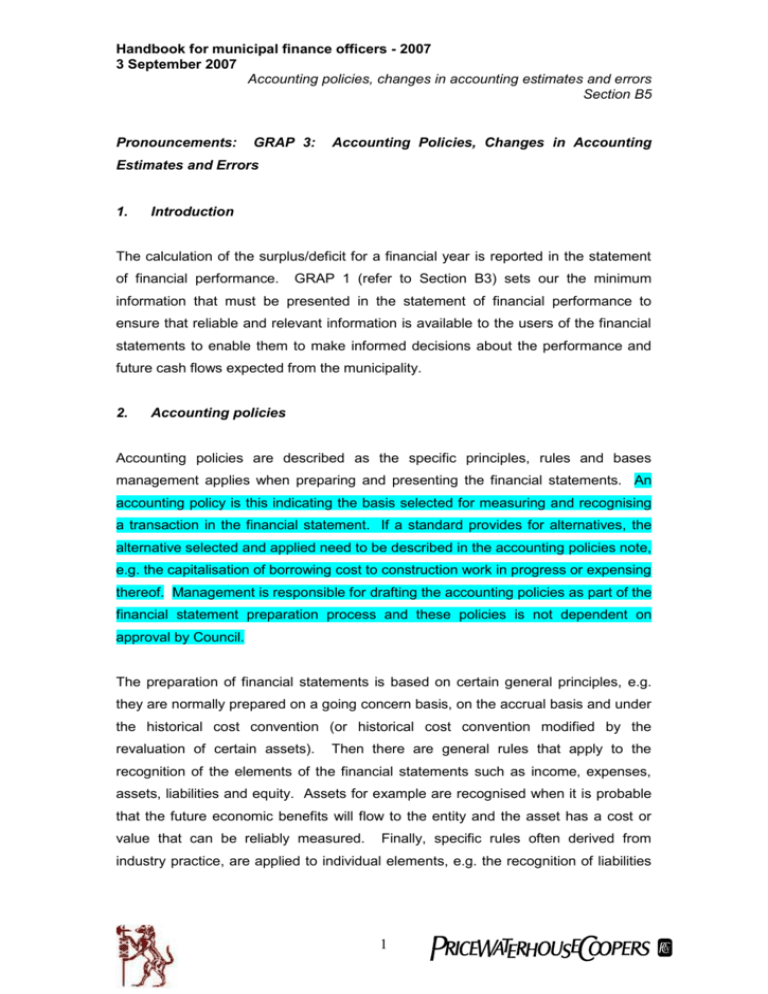
Handbook for municipal finance officers - 2007 3 September 2007 Accounting policies, changes in accounting estimates and errors Section B5 Pronouncements: GRAP 3: Accounting Policies, Changes in Accounting Estimates and Errors 1. Introduction The calculation of the surplus/deficit for a financial year is reported in the statement of financial performance. GRAP 1 (refer to Section B3) sets our the minimum information that must be presented in the statement of financial performance to ensure that reliable and relevant information is available to the users of the financial statements to enable them to make informed decisions about the performance and future cash flows expected from the municipality. 2. Accounting policies Accounting policies are described as the specific principles, rules and bases management applies when preparing and presenting the financial statements. An accounting policy is this indicating the basis selected for measuring and recognising a transaction in the financial statement. If a standard provides for alternatives, the alternative selected and applied need to be described in the accounting policies note, e.g. the capitalisation of borrowing cost to construction work in progress or expensing thereof. Management is responsible for drafting the accounting policies as part of the financial statement preparation process and these policies is not dependent on approval by Council. The preparation of financial statements is based on certain general principles, e.g. they are normally prepared on a going concern basis, on the accrual basis and under the historical cost convention (or historical cost convention modified by the revaluation of certain assets). Then there are general rules that apply to the recognition of the elements of the financial statements such as income, expenses, assets, liabilities and equity. Assets for example are recognised when it is probable that the future economic benefits will flow to the entity and the asset has a cost or value that can be reliably measured. Finally, specific rules often derived from industry practice, are applied to individual elements, e.g. the recognition of liabilities 1 Handbook for municipal finance officers - 2007 3 September 2007 Accounting policies, changes in accounting estimates and errors Section B5 for decommissioning in the oil industry. These principles are described in GRAP 1 – Presentation of Financial Statements. The ASB’s Framework sets out the objectives of financial statements and the concepts that underlie the preparation of financial statements for external users. Part of the Framework discusses the elements of financial statements in detail and the recognition criteria to be applied to those elements. For this reason, municipalities should not develop their own general principles for preparing their financial statements, insofar as they must generally use the going concern basis, recognise assets and liabilities only when they meet the definitions in the Framework. The framework also sets out the qualitative characteristics of financial statements. These are understandability, relevance, reliability and comparability. Materiality is referred to as a sub-principle of relevance. Also, reliability has several sub-principles. These are faithful representation, substance over form, neutrality, prudence and completeness. Using the framework as a basis, the ASB have issued a number of standards and interpretations, refer to Section B2, most of which lay down either single accounting policies to be applied in complying with the standard or, in a few cases, alternative accounting policies that may be followed. As a result selection of accounting policies by municipalities is to a large extent predetermined by existing standards. 2.1 Selection of accounting policies When a Standard of GRAP specifically applies to a transaction, other event or condition, the accounting policy or policies applied to that item shall be determined by applying the Standard and considering any relevant interpretations issued by the ASB for the Standard. Standards of GRAP set out accounting policies that the ASB has concluded result in financial statements containing relevant and reliable information about the transactions, other events and conditions to which they apply. Those policies need not be applied when the effect of applying them is immaterial. However, it is inappropriate to make, or leave uncorrected, immaterial departures from Standards 2 Handbook for municipal finance officers - 2007 3 September 2007 Accounting policies, changes in accounting estimates and errors Section B5 of GRAP to achieve a particular presentation of an entity’s financial position, financial performance or cash flows. In the absence of a particular Standard of GRAP that specifically applies to a transaction, other event or condition, management shall use its judgement in developing and applying an accounting policy that results in information that is: relevant to the economic decision-making needs of users; and reliable in that the financial statements: o represent faithfully the financial position, financial performance and cash flows of the entity; o reflect the economic substance of transactions, other events and conditions, and not merely the legal form; are neutral, e.g. free from bias; are prudent; and are complete in all material respects. If one or more alternative accounting policies (benchmark or allowed alternative) are available under a Standard of GRAP, an entity should choose and apply consistently one of those policies unless the Standard specifically requires or permits categorisation of items (transactions, events, balances, amounts, etc.) for which policies are to be chosen. If a Standard requires or permits separate categorisation of items, a single accounting policy should be selected and applied consistently to each category. Once an initial policy has been selected, a change in accounting policy should only be made in the manner explained in the paragraph hereunder on “Changes in accounting policies’. Management in making their judgement refer to and consider the applicability of, the following sources in descending order: the requirements and guidance in Standards of GRAP dealing with similar and related issues; and 3 Handbook for municipal finance officers - 2007 3 September 2007 Accounting policies, changes in accounting estimates and errors Section B5 the definitions, recognition criteria and measurement concepts for assets, liabilities, revenue and expenses set out in the Framework for the Preparation and Presentation of Financial Statements. Management may also consider the most recent pronouncements of other standardsetting bodies and accepted public or private sector practices to the extent, they are consistent with the sources listed above, e.g. pronouncements in descending order the: International Public Sector Accounting Standards Board (IPSASB); International Accounting Standards Board (IASB) (including the Framework for the Preparation and Presentation of Financial Statements); Accounting Practices Board (APB); and South African Institute of Chartered Accountants’ Accounting Practices Committee (APC). Standards of GRAP will supersede the equivalent new GAMAP Standards. In the reference to GRAP we this refers to the table indicating the applicable standards as set out in Section B2. Also refer to Section B0 for exemptions. A Standard of GRAP applies from the date determined in a regulation issued by the Minister, after consultation with the Board. Standards approved but not yet effective disclosure is needed: of this fact; and known or a reasonably estimate of information relevant to assessing the possible impact that application of the new Standard will have on the financial statements in the period of initial application. An entity considers disclosing: the title of the new Standard of GRAP; the nature of the impending change or changes in accounting policy; the date by which application of the Standard of GRAP is required; the date as at which it plans to apply the Standard of GRAP initially; and 4 Handbook for municipal finance officers - 2007 3 September 2007 Accounting policies, changes in accounting estimates and errors Section B5 either a discussion of the impact that initial application of the Standard is expected to have on the entity’s financial statements; or if that impact is not known or reasonably estimable, a statement to that effect. In the development of Standards of GRAP the ASB also considers the pronouncements as indicated to management for applying their judgement. Any deviations to IPSASB are listed at the end of the applicable Standard of GRAP. It is considered appropriate to refer to a Standard of GRAP approved but not yet effective in setting an accounting policy not guided by an existing Standard of GRAP to obtain an understanding of principles and guidelines applied in GAAP or IAS. To this end, GRAP 3’s starting point is that when a standard specifically applies to a transaction or event, the accounting policy applied to that item should be determined by the applying the standard and considering any relevant implementation guidance issued by the ASB or National Treasury, unless management believe that complying with a standard of GRAP will not result in fair presentation. A potential problem arises when a municipality encounter a transaction or event that is not specifically addressed by GRAP and there will be circumstances where this is the case. In such cases, GRAP 3 sets out a hierarchy of guidance to be considered in the selection of an accounting policy. The primary requirement is that management should use its judgement in developing and applying an accounting policy that results in information that remains relevant and reliable to the extent that it: faithfully represent the financial position, financial performance and cash flows, reflects the economic substance rather than legal form, and is neutral, prudent and complete. Each of the above concepts has been discussed in Section B2 dealing with the framework. Refer to the diagram included at the end of this paragraph. In support of this primary requirement, the standard gives guidance on information sources management should consider in applying judgement. 5 In the event Handbook for municipal finance officers - 2007 3 September 2007 Accounting policies, changes in accounting estimates and errors Section B5 management made use of “any other framework” in selecting accounting policies only the measurement and recognition criteria apply and not the disclosure requirements. The hierarchy of the additional sources of guidance can be illustrated as follows: Requirement and guidance in GRAP dealing with similar and related events Definition, recognition criteria and measurement concepts set out in the Framework Sources management should consider International Public Sector Accounting Standards Sources management may consider International Accounting Standards/ SA GAAP Accepted industry practices A municipality should apply its accounting policies consistently for similar transactions and categories of items and the same policies should be applied from one reporting period to the next. In order to ensure that the information published in the annual financial statements are not changed excessively often or in order to manipulate results, restrictions are in place to limit the circumstances in which a municipality is allowed to change an existing policy. Reference should be made to the specimen financial statements to gain an understanding of the accounting policies that could be developed and any guidance issued. Changes in accounting policies As business practices evolve, the needs of users changed and accordingly accounting standards or interpretations develop resulting in changes in accounting policies. 6 Handbook for municipal finance officers - 2007 3 September 2007 Accounting policies, changes in accounting estimates and errors Section B5 As discussed above, consistency of accounting policies is a basic principle in both GRAP 1 and 3. Accordingly, GRAP 3 only permits a change in accounting policies if: the change is required by a standard or an interpretation; or if the change will result in the financial statements providing reliable and more relevant information about the effects of transactions, other events or conditions on the entity’s financial position, financial performance or cash flows. The main sources leading to changes in accounting policies are: the initial application of a standard containing transitional provisions; and the initial application of a standard not containing transitional provisions. Early application of a Standard is not a voluntary change in accounting policy. If management, in the absence of a Standard of GRAP adopted accounting policies based on the most recent pronouncements of other standard setting bodies using a similar conceptual framework to develop standards and following an amendment of such pronouncement, management choose to change an accounting policy, that change is accounted for and disclosed as a voluntary change in accounting policy. Changes to accounting policies emanating from the introduction or revision of new standards containing transitional provisions and should be accounted for in accordance with those provisions, e.g. the implementation of GRAP/GAMAP following the using of “old GAMAP” would be treated as a change in accounting policy if the alignment of the “old” and “new” standards resulted in the adoption of different accounting policies. Any other changes in accounting policies should be applied retrospectively as if it had always applied – except where it is considered to be impractical. This is discussed later in this Section. Retrospective application requires the adjustment of the opening balance and comparative information for each affected line-item. If the adjustment relates to periods before the comparative year, it will be made against the opening balance of accumulated surplus/deficit. 7 Handbook for municipal finance officers - 2007 3 September 2007 Accounting policies, changes in accounting estimates and errors Section B5 The adoption of an accounting policy for events or transactions that have not occurred previously or that differ in substance from those that have occurred, is not regarded as a change in accounting policy and need not be disclosed as such, e.g. the initial application of a policy to revalue assets in accordance with the Standard of GRAP on Property, Plant and Equipment or the Standard of GRAP on Intangible Assets is a change in an accounting policy to be dealt with as a revaluation in accordance with the Standard of GRAP on Property, Plant and Equipment or the Standard of GRAP on Intangible Assets, rather than in accordance with the Standard of GRAP on Accounting Policies, Changes in Accounting Estimates and Errors. The following decision tree will assist in determining the appropriate application of changes in accounting policies: Is the change in accounting policy due to the implementation of a new standard? No Yes Voluntary change to provide more relevant and reliable information Does the standard contain any transitional provisions for implementation? Refer to hierarchy of authorative guidance for development of new policy Will it be practical to apply the change retrospectively according to the requirements of GRAP 3? Yes No Follow transitional provisions to account for change in policy No Subject to process in GRAP 3 8 Yes Apply new policy to current and prior periods as if policy has always been in place Handbook for municipal finance officers - 2007 3 September 2007 Accounting policies, changes in accounting estimates and errors Section B5 2.1 Disclosure of accounting policies GRAP 3 requires the disclosure of summarised accounting policies, focussing on the measurement basis used in preparing financial statements and other policies that are relevant to an understanding of the financial statements. Furthermore, GRAP 3 requires disclosure of the judgements management has made (excluding those involving estimates) in the process of applying the accounting policies, for an illustration refer to Example 5.01. In the disclosure of changes in accounting policies, distinction is made between changes due to the initial application of a standard and voluntary changes. a) Initial application of a standard When initial application of a standard has an effect on the current period and/or any prior periods, a municipality should disclose: the title of the standard; whether the change is made in accordance with the transitional provisions, along with a description of those provisions; the nature of the change; the amount of adjustment for each line-item affected, to the extent practicable; amounts of adjustments relating to prior periods; and the circumstances that led to the existence of conditions that caused retrospective application to be impracticable. b) Voluntary change in accounting policy When a voluntary change has an effect on the current period or any prior period, a municipality should disclose in addition to the above disclosures, the reasons why the new policy will provide information that is more reliable and relevant. 9 Handbook for municipal finance officers - 2007 3 September 2007 Accounting policies, changes in accounting estimates and errors Section B5 Example 5.01 – Comprehensive disclosure example (voluntary change in accounting policy) The following is an extract from the statement of financial performance prepared for Protea Municipality, prior to a voluntary decision to change the accounting policy for the valuation of inventory from the first-in-first-out formula to the weighted-average formula as it is the opinion of management that the weighted-average formula is a better reflection of the value of inventory giving recognition to utilisation patterns of individual items over time. An assumption is made that for illustration purpose Protea Municipality had only been established in 20x31. 20x5 13 500 (11 000) (2 700) (8 300) 2 500 Revenue Expenses Other expenses Consumables Surplus for the year 20x4 10 000 (8 000) (2 400) (5 600) 2 000 The accumulated surplus balance at 30 June 20x3 amounted to R2 000. The following summary was prepared of the closing inventory according to the first-in-first-out and weighted-average method: 20x5 R 1 500 1 200 300 Weighted average method (new) First-in-first-out method (old) Change in inventory 20x4 R 1 000 750 250 20x3 R 800 620 180 The cost of items consumed during the year is reflected as an expense in the statement of financial performance. The cost of consumables is calculated by adding the opening balance of inventory to purchases made during the year and deducting the closing balance on hand. The effect of the change in accounting policy would result in the restated cost of consumables, as follows: Cost of consumables previously reported (FIFO) Increase in opening balance Increase in closing balance Restated cost of consumables Thus, restated surplus for the year 20x5 8 300 250 (300) 20x4 5 600 180 (250) 8 250 2 550 5 530 2 070 Restatement of comparative figures The effect of the change in accounting policy for inventory should be presented in the statement of financial performance as if the new policy had always been applied. In other words, both the current year and the comparative year’s cost of consumables should be calculated using the new policy. 1 Changes is required to be applied retrospectively implying that the selected policy have always been applied and this recognising the effect prior to 20x3 in opening retained income for 20x4 10 Handbook for municipal finance officers - 2007 3 September 2007 Accounting policies, changes in accounting estimates and errors Section B5 Revenue Expenses Other expenses Consumables Surplus for the year 20x5 13 500 (11 000) (2 700) (8 250) 2 550 20x4 10 000 (8 000) (2 400) (5 530) 2 070 20x5 4 250 4 250 2 550 6 800 20x4 2 000 180 2 180 2 070 4 250 Statement of changes in net assets Balance at 1 July as previously reported Change in accounting policy (see note) Restated opening balance Surplus for the year (restated) Balance at 30 June As the comparative figures have been adjusted due to the change in accounting policy, the following additional note should be disclosed: Change in accounting policy 20x5 R During the current year the municipality changed its accounting policy for the valuation of inventory from the first-in-first-out method to the weighted-average method, because it results in a more transparent treatment of the cost of consumables and is consistent with local industry practice, making the financial statements more comparable. The change in accounting policy has been applied retrospectively by restating the comparative figures accordingly. Effect on 20x4 Decrease in cost of consumables and increase in surplus Effect on periods prior to 20x4 Increase in accumulated surplus 3. 70 180 Accounting estimates Although “accounting estimates” are not directly defined in GRAP, it is indirectly defined by the definition in GRAP 3 of a change in accounting estimate as an adjustment of the carrying amount of an item. Changes in accounting estimates result from new information or new developments and accordingly, are not corrections of errors, e.g. the provision for bad debts and the estimated useful life of a depreciable asset. Accounting estimates by nature, are approximations that may need revision as additional information becomes known. 11 Handbook for municipal finance officers - 2007 3 September 2007 Accounting policies, changes in accounting estimates and errors Section B5 The distinction between an accounting policy and an accounting estimate is particularly important because a very different treatment is required when there are changes in accounting policies or accounting estimates. When it is difficult to distinguish between a change in accounting policy and a change in estimate, GRAP 3 requires the change to be treated as a change in accounting estimate. The making of estimates is a fundamental feature of financial reporting reflecting the uncertainties inherent in business activities. GRAP 3 notes that the use of reasonable estimates is an essential part of the preparation of financial statements and it does not undermine its reliability. Owing to the inherent uncertainties in business activity, preparing financial statements is not an exact science and involves making numerous estimates. Estimates involve judgements based on the latest available, reliable information. They are applied, for example in: determining provision for doubtful debts; provision for slow moving or obsolete inventory; useful lives of tangible and intangible fixed assets; fair values of financial assets and financial liabilities; actuarial assumptions relating to defined benefit pension schemes; warranty provisions; and impairment provisions for property, plant and equipment and intangible assets. Estimates will need revision as changes occur in the circumstances on which they are based or as a result of new information or more experience. The standard observes that, by its nature, the revision of an estimate does not relate to prior periods and is not the correction of an error. Accordingly, GRAP 3 requires that changes in estimates be accounting for prospectively – recognising the effect of the change in the current and future periods. This means that the carrying amount of the asset or liability will be adjusted in the current period and the change in estimate is recognised in the statement of financial performance in current period if it affects the current period only (e.g. provision for bad debt), or in the current and future periods if it affects both (e.g. change in useful life). 12 Handbook for municipal finance officers - 2007 3 September 2007 Accounting policies, changes in accounting estimates and errors Section B5 In particular, GRAP 3 considers a change in measurement basis to be a change in accounting policy rather than a change in estimate. The following measurement bases are discussed in the framework (refer to Section B2): historical cost; current replacement cost; net realisable value; fair value; and recoverable value. Example 5.02 – Change in accounting estimate A municipality bought a tractor for R500 000 on 1 July 20x3. The useful life of the machine at this date was estimated at 5 years, with no residual value at the end of this period. The depreciation charge for the 20x5 reporting year was R100 000 (R500 000/5). At 1 July 20x6 the tractor was included in the fixed asset register as follows: R 500 000 (200,000) 300 000 Cost price Accumulated depreciation (500 000/5 x 2) Carrying value as at 31 June 20x5 Due to the good service records of the tractor, management estimated at 30 June 20x6 that the machine had an estimated useful life of seven years. In other words, it was estimated that the machine would be used productively for a further 4 years. The depreciation charge for the remainder of its useful life is R50 000 (200 000/4). Note that the change is only applied prospectively – depreciation charges incurred before the change in estimate are not adjusted. The tractor’s depreciation charges over its expected useful life can be summarised as follows: R 100 000 100 000 100 000 50 000 50 000 50 000 50 000 30 June 20x4 30 June 20x5 30 June 20x6 30 June 20x7 30 June 20x8 30 June 20x9 30 June 20X10 Disclosure GRAP 3 requires disclosure in the notes to the financial statements information about the key assumptions concerning the future and other key sources of estimation uncertainty at the reporting date, that have a significant risk of causing material adjustments in subsequent financial years. In respect of those assets and liabilities, 13 Handbook for municipal finance officers - 2007 3 September 2007 Accounting policies, changes in accounting estimates and errors Section B5 the notes should include details of the nature of the assumptions, the sensitivity of carrying values to estimates underlying their calculation, expected outcome of uncertainty and an explanation of changes made to past assumptions. The disclosure of assumptions and estimates should also take into account disclosures required by other standards such as GAMAP 17 and 19. GRAP 3 further requires the disclosure of the nature and amount of a change in accounting estimates that will have an effect on the current and future periods. Example 5.03 – Disclosure of changes in estimates Extract of the Statement of financial position of Protea Municipality for the year ended 30 June 20x7 ASSETS Notes 20x7 20x6 Non current assets Property plant and equipment 2 150,000 200,000 Extract of the Notes to the financial statements of Protea Municipality for the year ended 30 June 20x7 1. Extract of property plant and equipment accounting policy notes The depreciation methods, estimated remaining useful lives and residual values are reviewed on an annual basis. 14 Handbook for municipal finance officers - 2007 3 September 2007 Accounting policies, changes in accounting estimates and errors Section B5 2. Extract of the Property Plant and Equipment Note Plant and Machinery R Year ended 30 June 20x6 Opening balance 300 000 Cost 500 000 Accumulated depreciation -200 000 Additions - Disposals - Cost - Accumulated depreciation - Depreciation -100 000 Closing balance 30 June 20x6 200 000 Cost 500 000 Accumulated depreciation -300 000 Year end 30 June 20x7 Opening balance 200 000 Additions - Disposals - Cost - Accumulated depreciation - Depreciation (50 000) Current year provision (100 000) Change in estimate 50 000 Closing balance- 30 June 20x7 150 000 Cost 500 000 Accumulated depreciation (350 000) 3. Change in accounting estimate note Useful economic lives of tangible assets A review of useful economic lives of tangible assets was performed during the year and management decided that due to the good service records of the tractor, the useful life be reassed from the initial 5 years to the total useful life of 6 years as at 1 June 20x6. This resulted in an reduced depreciation charge of R50,000 for the year, which is expected to recur over the remaining life of the asset (tractor). 15 Handbook for municipal finance officers - 2007 3 September 2007 Accounting policies, changes in accounting estimates and errors Section B5 Effects on the current year profits (20x7) o Increase/(Decrease) in profits R50 000 Effect on future periods profits o 4. Increase/(Decrease) in profits R50 000 Errors Errors are referred to as omissions from and/or misstatements in the financial statements. An error identified in the comparative figures should be corrected by restating the comparative figures. If the error was made in a period prior to the comparative year, it should be corrected in the opening balances of the prior year. An error implies that the municipality did something wrong – either intentionally to achieve a certain result or by mistake, e.g. mathematical mistake or incorrect application of accounting policy. This means that any person could reasonably have expected that such error would have been taken into account and corrected, had it been known. The distinction between changes in estimates and errors can be explained as being “a change in estimate occur as a result of new information or more experience, whereas errors are based on information or situations that existed at the time and could have reasonably be expected to have been detected at the time that the error occurred”. When it is discovered that an error occurred, GRAP 3 requires that it be corrected in the first set of financial statements prepared after their discovery. The correction should be excluded from the surplus or deficit for the period in which it was discovered. Instead the error is corrected in the period that it occurred. If the error occurred in the prior year, the comparatives are restated; if the error occurred in prior years, the opening balances in the comparative period are restated. Rather, any information presented about prior periods should be restated as far back as possible. This process is described as retrospective application (see changes in accounting policies). 16 Handbook for municipal finance officers - 2007 3 September 2007 Accounting policies, changes in accounting estimates and errors Section B5 Disclosure When correction has been made for material prior period errors, the following disclosures are required: the nature of the error; for each prior period presented, the amount of correction for each line-item affected; amount of correction at beginning of comparative period; and if retrospective restatement is impractical, the circumstances that led to such conditions. Example 5.04 – Disclosure of the correction of an error The following statement of financial performance was prepared for Protea Municipality prior to identifying an understatement of R500 in the operating expenses for the reporting period that ended on 30 June 20x3. 20x5 R 13 500 (11 000) (2 700) (8 300) 2 500 Revenue Expenses Operating expenses Consumables Surplus for the year 20x4 R 10 000 (8 000) (2 400) (5 600) 2 000 The error identified resulted from expenses payable at 30 June 20x3 that should have been expensed during that year. The expenses were incorrectly recognised in the current (20x5) financial year, when in fact they related to the 20x3 financial year. The error should have been corrected at the time when it occurred, however, the error was detected during the current financial year, resulting in the expenses being included in the current year. By correcting this error during the current year, the following accounting entry should be processed: Debit R 500 Accumulated surplus Operating expenses Credit R 500 The error should be corrected in the statement of financial performance as if it never occurred, as follows: 20x5 R 13 500 (11 000) (2 200) (8 300) 3 000 Revenue Expenses Operating expenses Consumables Surplus for the year 17 20x4 R 10 000 (8 000) (2 400) (5 600) 2 000 Handbook for municipal finance officers - 2007 3 September 2007 Accounting policies, changes in accounting estimates and errors Section B5 Statement of changes in net assets 20x5 R 9 500 9 500 3 000 12 500 Balance at 1 July as previously reported Correction of error (see note) Restated opening balance Surplus for the year (restated) Balance at 30 June 20x4 R 8 000 (500) 7 500 2 000 9 500 The effect of the error should be disclosed in the notes to the financial statements as follows: Correction of error 20x5 R Operating expenses were omitted from the surplus for the financial year which ended on 30 June 20x3. The effect of this error are summarised as follows: Increase in operating expenses Decrease in surplus for the year 500 (500) Increase in liabilities Decrease in accumulated surplus 500 (500) The previous method of recording prior-year adjustments directly against the appropriation account is no longer allowed. If the previous financial statements were misstated and the amount is material, the comparative amounts must be restated and the detail surrounding the error disclosed in the financial statements. If the misstatement in the prior period financial statements was immaterial, the correction is made in the current financial statements. 5. Impracticability As noted previously, GRAP 3 does not require the restatement of prior periods following a change in accounting policy or the correction of an error is such a restatement is impractical, e.g. a lack of sufficient information to determine the effect and management has proven or shown without reasonable doubt that the restatement is impossible. A considerable amount of guidance is devoted to what constitutes “impractical”. Impractical implies that applying a requirement retrospectively is not possible after making every reasonable effort to do so. It is impractical to apply a change in accounting policy retrospectively or make a retrospective correction of an error if: the effects are not determinable; 18 Handbook for municipal finance officers - 2007 3 September 2007 Accounting policies, changes in accounting estimates and errors Section B5 it requires assumptions about management’s intentions during the affected period that cannot be confirmed; and it requires significant estimates of amounts and it is impossible to distinguish information about those estimates that provides evidence of circumstances that existed on that date and would have been available when the financial statements were issued, from other information. An example where it may be impractical to adjust comparative information is where the data may not have been collected in the prior periods in a way that allows retrospective application of the accounting policy, for example assessing useful life of an asset annually, e.g. historically municipalities were required to record assets at cost but not necessary the extend of detail required to identify the asset subsequently or to estimate the remaining useful life. As a result the information that would have enabled them to calculate accumulated depreciation retrospectively have not be recorded in the fixed asset registers. It will most probably be impractical for them to apply such an accounting policy retrospectively. To the extent that it is impracticable to determine either the period-specific effects or the cumulative effects of changing an accounting policy, retrospective application is not required. Retrospectively applying a new accounting policy requires distinguishing information that provides evidence of circumstances that existed on the date at which the transaction, other event or condition occurred and that would have been available when the financial statements for that period were authorised for issue. In other words, GRAP 3 does not permit the use of hindsight when applying a new accounting policy. Transitional provisions The Standard of GRAP on Accounting Policies, Changes in Accounting Estimates and Errors contains no transitional provisions. Exemptions Refer to Section B0. 19


